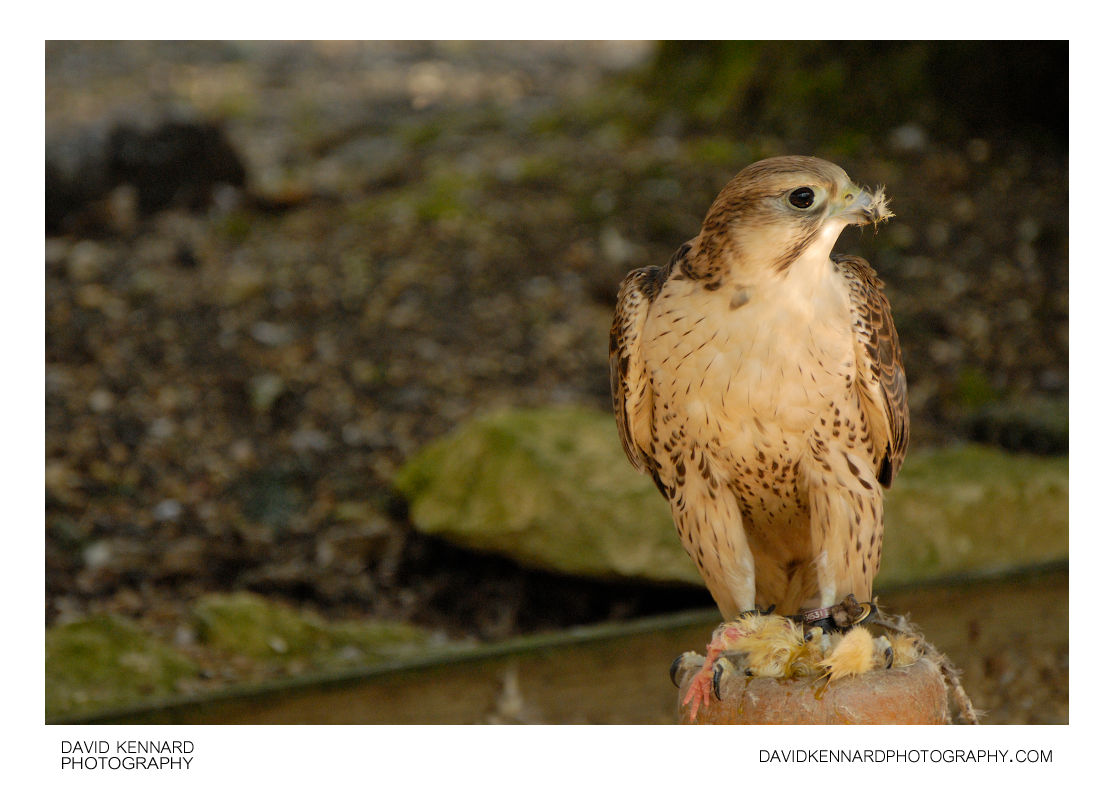Captive Falcon eating a chick

Description
- Title:
- Captive Falcon eating a chick
- Caption / Description:
-
A Falcon eats a chick at the Rutland Falconry & Owl Centre, the centre gets through around 400 cockerel chicks every day.
Description from Wikipedia: http://en.wikipedia.org/wiki/Falcon
A falcon is any species of raptor in the genus Falco. The word comes from their Latin name falco, related to Latin falx ("sickle") because of the shape of these birds' wings.
Adult falcons have thin tapered wings, which enable them to fly at high speed and to change direction rapidly. Fledgling falcons, in their first year of flying, have longer flight feathers which makes their configuration more like that of a general-purpose bird such as a broadwing. This is to make it easier for them to fly while learning the exceptional skills required to be effective hunters as adults.
Peregrine Falcons have been recorded diving at speeds of 200 miles per hour (320 km/h), making them the fastest-moving creatures on Earth. Other falcons include the Gyrfalcon, Lanner Falcon, and the Merlin. Some small falcons with long narrow wings are called hobbies, and some which hover while hunting are called kestrels. The falcons are part of the family Falconidae, which also includes the caracaras, Laughing Falcon, forest falcons, and falconets.
The traditional term for a male falcon is tercel (British spelling) or tiercel (American spelling), from Latin tertius = third because of the belief that only one in three eggs hatched a male bird. Some sources give the etymology as deriving from the fact that a male falcon is approximately one third smaller than the female (Old French tiercelet).
A falcon chick, especially one reared for falconry, that is still in its downy stage is known as an eyas (sometimes spelt eyass). The word arose by mistaken division of Old French un niais, from Latin presumed
nidiscus ("nestling", from nidus = nest).The technique of hunting with trained captive birds of prey is known as falconry.
As is the case with many birds of prey, falcons are renowned for their exceptional powers of vision; one species has been found to have a visual acuity of 2.6 times that of a normal human.
In February 2005, the Canadian ornithologist Louis Lefebvre announced a method of measuring avian intelligence in terms of their innovation in feeding habits. The falcon and corvids scored highest on this scale.
- Tags / Keywords:
-
- Biota
- Life
- Vitae
- Eukaryota
- Animalia
- Animals
- Chordata
- Chordates
- Aves
- Birds
- Falconiformes
- Falconidae
- Falcons and Caracaras
- Falco
Admin
- Date Original Photo Taken:
- Original File Name:
- _DSC8802.NEF
- Event:
- Rating:
- Date this image added/last updated on website:
- Original File Dimensions:
- 3872px x 2592px
- File Type:
- JPEG
- Color Mode:
- RGB
- Original Image Color Profile:
- Nikon Adobe RGB 4.0.0.3001
Location
- Location Shown:
-
- Sublocation:
- Rutland Falconry & Owl Centre
- City:
- Oakham
- Province/State:
- Rutland
- Country:
- United Kingdom
- World Region:
- Europe
- Location Created:
-
- Sublocation:
- Rutland Falconry & Owl Centre
- City:
- Oakham
- Province/State:
- Rutland
- Country:
- United Kingdom
- World Region:
- Europe
- Geo-location:
- 52.682067818056, -0.66309676472222 View on map
Rights
- Copyright Status:
- Copyrighted
- Licensing Status:
- Rights Managed
- Available for Editorial Use:
- Yes
- Available for Commercial Use:
- No
- Copyright Notice:
- © 2010 Dave Kennard
Camera Data
- Date Digital Resource was created:
- Shutter speed:
- 1⁄180 s
- Aperture:
- f/5.6
- Camera Model:
- Nikon D200
- ISO:
- 800
- Exposure Compensation:
- 0
- Focal Length:
- 300mm
- Focal Length (35mm equiv.):
- 450mm
- Metering Mode:
- Multi-segment
- Flash:
- No Flash
- Exposure Mode:
- Auto
- White Balance:
- Manual
- Light Source:
- Cloudy
- Exposure Program:
- Aperture-priority AE
Additional shooting metadata
- Lens:
- Nikon AF-S VR Zoom Nikkor ED 70-300mm F4.5-5.6G(IF)
- Filters used:
-
- B+W UV 010 MRC
- Additional Optics used:
- Setup:
- Handheld
Post Processing
- Image Modified:
- Software used:
-
- Nikon Capture NX 2
- Post Processing:
